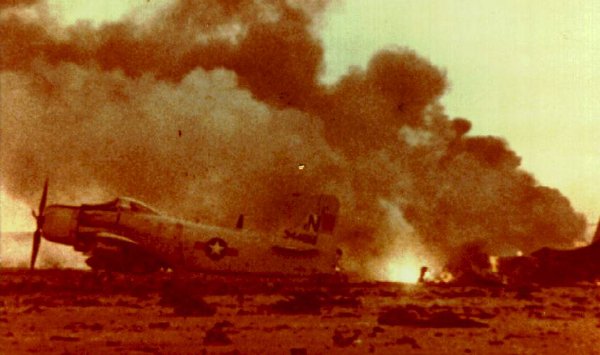The decision to fund Navy explosives research programs to develop less sensitive materials followed a number of unexpected munition explosions of that occurred during the Vietnam War. One of the first incidents that served to center attention on the importance of munition sensitivity occurred in 1965. A fire, set by enemy action, occurred at the ammunition storage area at Bien-Hoa air base in Vietnam. Within a short time, munitions detonated spreading the fire.
Bien-Hoa Air Base, Vietnam 1965. Munition storage area fire and secondary
Fire and secondary explosions destroyed the entire ammunition storage area at the air base. Thirty-three Servicemen were killed and many tons of ammunition were lost. Shortly after this incident, the Army initiated a program at the Aberdeen Proving Ground, MD to study ammunition storage and ways to minimize sympathetic detonations of munition stockpiles.
Accidents aboard ships soon attracted the Navy’s attention. In 1968, the Navy started having problems with in-bore detonations of projectiles in 5-inch gun barrels. Later, bombs and warheads loaded with Composition B detonated in fires aboard aircraft carriers. The details will follow later but in response to the accidents aboard ships the Navy expanded the scope of its fiscal year 1970 explosives research program. The objective was to produce powerful explosives that were less sensitive to shock and heat than the conventional explosives then in use. The research laboratories were given two specific tasks: 1) to develop explosives that did not react violently in fuel fires and 2) to develop explosives that would not detonate in-bore when exposed to the set back forces such as experienced in 5-inch/54-caliber gun firings.
We at Navy headquarters believed that the damage resulting from the unplanned detonation of munitions could be minimized with less sensitive solid propellant-type explosives. The work orders and contracts issued tasked the researchers to develop new explosive compositions for use in large caliber guns that were as insensitive an Explosive D (ammonium picrate) but as powerful as Composition A-3 (91%RDX/9%wax) and Composition B (60%RDX/40%TNT/+1%wax).
Explosive D is a very insensitive low energy explosive introduced during World War I to replace black powder as the main charge in Navy projectiles. Composition A-3 was introduced during World War II and is used in three and five inch Navy projectiles. Comp A-3 was a powerful explosive used to improve the effectiveness of the Navy anti-aircraft guns against the Kamikaze17 suicide attack planes launched by the Japanese against U.S. ships in the Pacific theater. Composition B, also a powerful explosive, was developed independently by the British and the Germans before World War II. It was used mainly in Army projectiles and in rocket warheads, shaped charges, and bombs.
As mentioned above, several catastrophic incidents had occurred on Navy warships during military and training operations. Also, munitions had been involved in and in train and truck transport explosions in the U.S. In all cases, the incidents had occurred where there was no enemy action to blame or even suspect.
17Kamikazes were Japanese suicide pilots who attempted to dive airplanes loaded with explosives into selected targets during World War II.
